|
When it comes to Poles of the Napoleonic era,
consider how hard a proud people fight
when they have no homeland of their own,
and they feel that following one man, Napoleon
is their best chance to get one.
|

Polish Army During the Napoleonic Wars.
"Poland Has Not Perished Yet,
As Long As We Are Alive."
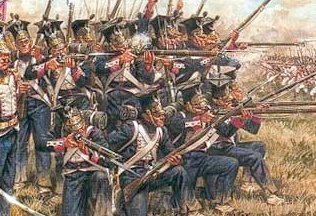 Norman Davies writes: "Few nations in the last 200 years have seen more military action than
the Poles.
In the 18th century, as in the 20th, the Polish lands regularly provided an arena for Europe's wars.
In the 19th century, they supplied the armies of three martial empires with numberless recruits and conscripts.
Yet no European nation has reaped fewer rewards for the sweat and blood expended.
As often as not, the Polish soldier has followed foreign colors. ... It is sad fact, but Poland has been
obliged by circumstances to act as one of Europe's principal nurseries of cannon-fodder.
... Private armies abounded. ... Poland-Lithuania was not short of soldiers. Vast numbers of indigent petty noblemen filled the ranks of a military caste of proportions unequelled
in Europe. But their contempt for state service, their preoccupation with private wars and vendettas, their
perpetuation of the myth of the 'Noble Host', their dislike of drill, their obsession with cavalry to
the detriment of all other branches of warfare, and their opposition to the idea of raising an 'ignoble army' of peasant conscripts,
put them at a marked disadvantage in relation to all their neighbours. ...
By 1781, the ratio of trained soldiers in the service of the state to the adult male population had reached 1:472.
The derisory statistic compared with:
Norman Davies writes: "Few nations in the last 200 years have seen more military action than
the Poles.
In the 18th century, as in the 20th, the Polish lands regularly provided an arena for Europe's wars.
In the 19th century, they supplied the armies of three martial empires with numberless recruits and conscripts.
Yet no European nation has reaped fewer rewards for the sweat and blood expended.
As often as not, the Polish soldier has followed foreign colors. ... It is sad fact, but Poland has been
obliged by circumstances to act as one of Europe's principal nurseries of cannon-fodder.
... Private armies abounded. ... Poland-Lithuania was not short of soldiers. Vast numbers of indigent petty noblemen filled the ranks of a military caste of proportions unequelled
in Europe. But their contempt for state service, their preoccupation with private wars and vendettas, their
perpetuation of the myth of the 'Noble Host', their dislike of drill, their obsession with cavalry to
the detriment of all other branches of warfare, and their opposition to the idea of raising an 'ignoble army' of peasant conscripts,
put them at a marked disadvantage in relation to all their neighbours. ...
By 1781, the ratio of trained soldiers in the service of the state to the adult male population had reached 1:472.
The derisory statistic compared with:
- 1:153 in France
- 1:90 in Austria
- 1:49 in Russia
- 1:26 in Prussia.
Here was a fine paradox indeed. Europe's most militarized society was incapable of defending itself.
... From 1765 to 1831, constant attempts were made to develop Polish military potential to a level commensurate with that of the neighbouring countries.
... The revival began in 1765 with the founding of the Cadet Corps, a military college designed to raise
a new generation of officers in the spirit of patriotism and enlightement. ... The artillery corps was refounded; the cavalry was reorganized ...
By 1788, when the Great Sejm first voted for a standing army of 100,000 men, the capacity to realize this goal
undoubtedly existed. ... The Napoleonic episode initiated three decades of strong French influence. If the impact of the Legions was
mainly psychological, the introduction of 6-year conscription in 1807, affecting every man in the Duchy of Warsaw between 21 and 28 years of age, brought
military experience and training to the broad mass of the population. Napoleonic strategy and tactics
of surprise and attack were well matched to memoirs of the Polish nobility's fighting habits and to legends of Tarnowski and Sobieski."
(Davies - "God's Playground. A History of Poland." Vol II, p 268)
In 1797 in Italy was formed a Polish Legion, fighting for France against Austria.
There is hardly a more touching chapter in the world's history than the story of the Polish Legions. The Poles hoped that by fighting on the French side against Austria, Russia and Prussia, the contries that had partitioned Poland they could free their country.
Two years after the last dismemberment of Poland, a Polish army was formed, in Polish
uniforms, under Polish command, decorated with French cockades and wearing on the
eppaulets the inscription: "Gli uomini liberi sono fratelli." (Free men are brethren.)
The Polish soldiers without the state sung their battle-song: "Poland has not perished yet,
as long as we are alive" and fought in numerous battles and campaigns alongside the French.
 The Polish Legion under General Dabrowski fought with Bonaparte in his earliest campaigns in Italy.
These were the beginnings of Polish forces of Napoleonic period. These legions however were never used for purposes related to Polish independence. Some were posted to pacification duties in occupied Italy and in 1802-3 were drafted
with the expedition sent to crush the rebellion of Negro slaves on Santo Domingo. They died in their thousands from swamp fever.
In 1801 at Luneville, Napoleon made peace with his enemies and all agitation on the Polish Question was terminated.
In Polish aristocratic circles, the prospect of a French alliance was clouded by the associated threat
of social revolution. Soem aristocrats were laying plans of their won for the restoration of a united Poland
under the aegis of the new Tsar of Russia, Alexander I.
The Polish Legion under General Dabrowski fought with Bonaparte in his earliest campaigns in Italy.
These were the beginnings of Polish forces of Napoleonic period. These legions however were never used for purposes related to Polish independence. Some were posted to pacification duties in occupied Italy and in 1802-3 were drafted
with the expedition sent to crush the rebellion of Negro slaves on Santo Domingo. They died in their thousands from swamp fever.
In 1801 at Luneville, Napoleon made peace with his enemies and all agitation on the Polish Question was terminated.
In Polish aristocratic circles, the prospect of a French alliance was clouded by the associated threat
of social revolution. Soem aristocrats were laying plans of their won for the restoration of a united Poland
under the aegis of the new Tsar of Russia, Alexander I.
There was rivalry within the officers and generals between those who had served in the army of the Duchy of Warsaw and those
who had joined Polish units in French service. The former often felt the latter had put self interest before patriotic duty,
while the latter scorned the former as military amateurs. The rivalry had been largely healthy, and
there had in fact been considerable interchange between the two.
Chlapowski writes: "It was marvelous to be back in Warsaw. ... there was a great difference
between these new regiments and the Polish Guard and Vistula Legion, with which I had
recently been in Spain. As well as Col. Krasinski, the entire staff of the Polish Guard Lighthorse were experienced officers ...
The Vistula Legion still had officers from Dabrowski's Italian Legion and even Kniaziewicz's Legion of the Rhine. Nearly all the NCOs were older men, so training was steady, severe,
and regular. It wasn't like that in the army of the Duchy of Warsaw. The infantry was admittedly first class, but the cavalry still needed a lot of work.
... The artillery had only very few qualified officers, but the gunners were quite well trained.
The whole army was learning and its excellent spirit, liveliness and cheerful confidence bade well
for the future."
Polish officers and generals communicated in Polish and French language.
The troops were organized after the French model and used much of its terminology.
Chlapowski writes: "Our drill regulations were provided by General Dabrowski, translated from the French. Knowing the Prussian system, it was easy for me to learn these new regulations, which
were far simpler and much better suited to the conduct of war." (Chlapowski/Simmons - p 13)

1806-1808
"... there were plenty of young men [in Poland]
determined to prove their prowess on
the battlefield." - Norman Davies
 According to Norman Davies the Polish affairs were subordinated to the rivalry between Napoleon and the Allies.
Any Polish state that was to be created would, of necessity, be an expression more of the Balance of Power than
of the wishes of the people. The Duchy of Warsaw was a child of war.
In the years 1806-1807 Napoleon defeated Austria, Prussia and Russia. Under the Treaty of
Tilsit the Duchy of Warsaw was established on part of the lands of Prussian-annexed Poland.
It was placed under the guardianship of the King of Saxony. The constitution given by
Napoleon in July 1807 established the Polish army at 30,000 men. Prince Poniatowski became
its Minister of War. The Poles joked about the Duchy having "a Saxon king, French laws,
Polish army, and Prussian currency." (Nafziger and Wesolowski - "Poles and Saxons" p 3)
According to Norman Davies the Polish affairs were subordinated to the rivalry between Napoleon and the Allies.
Any Polish state that was to be created would, of necessity, be an expression more of the Balance of Power than
of the wishes of the people. The Duchy of Warsaw was a child of war.
In the years 1806-1807 Napoleon defeated Austria, Prussia and Russia. Under the Treaty of
Tilsit the Duchy of Warsaw was established on part of the lands of Prussian-annexed Poland.
It was placed under the guardianship of the King of Saxony. The constitution given by
Napoleon in July 1807 established the Polish army at 30,000 men. Prince Poniatowski became
its Minister of War. The Poles joked about the Duchy having "a Saxon king, French laws,
Polish army, and Prussian currency." (Nafziger and Wesolowski - "Poles and Saxons" p 3)
The Polish liaison with France could be traced back well beyond Kosciuszko's Raising to the Confederation of Bar and Le bon roi Stanislas.
But after the Reolution, there was a direct bond of common interest between the governments in Paris
challenging the Ancien Regime in the West, and the principal victim of the dynastic empires in the East.
Napoleon took a personal interest in the Polish Question, especially when it promised to supply him with
new soldiers.
Chlapowski writes: "In Nov 1806, the French armies arrived in Poznan [Posen]. The 1st Chasseurs-Cheval,
under Colonel Exelmans, who would later become a famous general, where the first to enter the [Polish] city as evening fell.
The I Squadron hurried at the trot right through the city with swords drawn, to place pickets on the other side of the Warta River, on the Warsaw and Torun [Thorn] roads.
The rest of the regiment stood peacefully in the market square, where a part of the population
came cheering to welcome them. ... The French ... after talking to the townspeaople pressing around them, they confirmed the impression already gained
from a few days march ... that they were in friendly territory. They billeted themselves peacefully around the city."
(Chlapowski / Simmons - p 8)
In November 1806 Napoleon directed General Dabrowski to form Polish troops.
Dabrowski issued a decree ordering the population to provide 1 infantry recruit from every
10 households, 1 cavalry recruit from every 45 households and 1 chasseur (light infantry)
recruit from every estate. In January 1807 the Polish army consisted of 20.500 recruits
and approx. 3.000 volunteers. The army was organized into three legions (divisions).
In August Marshal Davout selected the best infantry regiment of every division
and Napoleon took these units to Spain. "Napoleon took this force into French service on
much the same basis as the Hessians served the British in the American Revolution."
(Nafziger - "Poles and Saxons" p 12) The chosen troops were: 4th, 7th and 9th
Infantry Regiment, 140-men artillery company and 200-man sapper company.
Several battalions were sent to Prussia. Due to such wide distribution of Polish
troops the divisional organization had become obsolete.
"On March 16 1808 Napoleon decided that the Vistula Legion
could, if the need arose, be sent to the aid of the King of Saxony without arousing
particular attention." (Nafziger - "Poles and Saxons" p 79)
In the end of 1807 the army consisted of:
12 infantry regiments
6 cavalry regiments
3 battalions of artillery.
In February 1808 the Polish Legion du Nord was incorporated into the Polish army.
The Polish troops participated in the campaign of 1807.
On 27th January 1807 they fought at Tczew (Dirschau), on 14th February they took Gniew (Mewe)
and on 20th captured Slupsk (Stolpen). On 23rd February they took Tczew (Dirschau).
Napoleon awarded GdD Dabrowski with cross of the Legion d'Honneur.
In March-May 9.000 Polish troops (attached to French divisions) participated in
the siege of Gdansk (Danzig). The Poles suffered approx. 2.000 killed and wounded.
The Poles also participated in the Battle of Friedland.
In November 1808, Napoleon was in Spain, marching on Madrid. His advance was blocked by Spanish troops.
The Spaniards held the narrow defile of Somosierra, leading on to the lofty plateau where Madrid stands.
Sixteen guns were holding off Napoleon's army. After repeated attempts to force the position
with infantry, the regiment of Polish lighthorsemen were given the order to charge. Approx. 200 men obeyed and eight minutes later, the survivors emerged from the top
of the hill, "a thousand feet and three miles above the admiring Emperor." (Norman Davies p. 301)
All the cannons were taken and enemy's resistance was broken.
In later years, talk of the charge of Somosierra evoked the same reactions in Warsaw as
mention of the charge of the Light Brigade in London. The flower of the nation's youth was thought
to have perished in a distant land for the sake of a courageous gesture. In fact, the exemplary sacrifice of those few men ensured the passage
of a whole army.
|
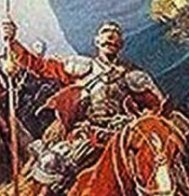


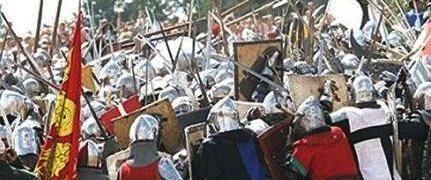 In the Middle Ages and later there persisted a common false belief that the Vandals
(
In the Middle Ages and later there persisted a common false belief that the Vandals
(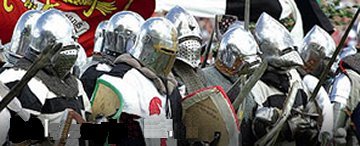 The XII-XIII centuries were a period of demographic growth until 1241-1287 when great
destruction was wrought by the invasions of the Mongols.
The Polish and German knights were defeated at Legnica, yet Poland preserved her independence,
avoiding the fate that had befallen Ruthenia and Russia, both conquered by the Mongols.
In XIV century, France, Germany, England and Italy were in the grip of the shocks of the
epidemic plaque called Black Death. For Poland it was a century of an
accelerated growth in economy, politics and military.
The XII-XIII centuries were a period of demographic growth until 1241-1287 when great
destruction was wrought by the invasions of the Mongols.
The Polish and German knights were defeated at Legnica, yet Poland preserved her independence,
avoiding the fate that had befallen Ruthenia and Russia, both conquered by the Mongols.
In XIV century, France, Germany, England and Italy were in the grip of the shocks of the
epidemic plaque called Black Death. For Poland it was a century of an
accelerated growth in economy, politics and military.
 In 1240, the Mongol terror from the east invaded Poland, having first decimated many other countries to the east.
(For example nearly all Russia became tributary to the Mongols.) The scouts of Khan Ougedei even reached France !
In 1241 the Mongols defeated a combined Polish-German force at
In 1240, the Mongol terror from the east invaded Poland, having first decimated many other countries to the east.
(For example nearly all Russia became tributary to the Mongols.) The scouts of Khan Ougedei even reached France !
In 1241 the Mongols defeated a combined Polish-German force at 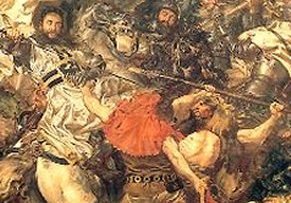 On picture: Ulrich von Jungingen, the Grand Master of the Teutonic
Order, was pulled down from his horse by the Poles and killed without mercy.
After his death the fight degenerated into a slaughter. The Battle of Grunwald was the
biggest medieval battle in Europe.
On picture: Ulrich von Jungingen, the Grand Master of the Teutonic
Order, was pulled down from his horse by the Poles and killed without mercy.
After his death the fight degenerated into a slaughter. The Battle of Grunwald was the
biggest medieval battle in Europe. On map: Europe in 1550.
On map: Europe in 1550.
 On picture: charge of the winged husaria by
On picture: charge of the winged husaria by

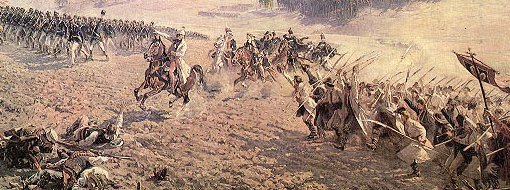 On picture: Polish regular infantry (left) and farmers armed with
scytes (right) at the Battle of Raclwice.
On picture: Polish regular infantry (left) and farmers armed with
scytes (right) at the Battle of Raclwice.  In 1794 General Kosciuszko, a veteran of the American Revolutionary War pronounced the general
uprising and assumed the powers of the commander in chief of the entire Polish Army.
The great difficulties with providing enough armament for the mobilised troops made Kosciuszko
form units composed of pesants armoured with scythes called
kosynierzy (see picture).
In 1794 General Kosciuszko, a veteran of the American Revolutionary War pronounced the general
uprising and assumed the powers of the commander in chief of the entire Polish Army.
The great difficulties with providing enough armament for the mobilised troops made Kosciuszko
form units composed of pesants armoured with scythes called
kosynierzy (see picture).




 Norman Davies writes: "Few nations in the last 200 years have seen more military action than
the Poles.
In the 18th century, as in the 20th, the Polish lands regularly provided an arena for Europe's wars.
In the 19th century, they supplied the armies of three martial empires with numberless recruits and conscripts.
Yet no European nation has reaped fewer rewards for the sweat and blood expended.
As often as not, the Polish soldier has followed foreign colors. ... It is sad fact, but Poland has been
obliged by circumstances to act as one of Europe's principal nurseries of cannon-fodder.
... Private armies abounded. ... Poland-Lithuania was not short of soldiers. Vast numbers of indigent petty noblemen filled the ranks of a military caste of proportions unequelled
in Europe. But their contempt for state service, their preoccupation with private wars and vendettas, their
perpetuation of the myth of the 'Noble Host', their dislike of drill, their obsession with cavalry to
the detriment of all other branches of warfare, and their opposition to the idea of raising an 'ignoble army' of peasant conscripts,
put them at a marked disadvantage in relation to all their neighbours. ...
By 1781, the ratio of trained soldiers in the service of the state to the adult male population had reached 1:472.
The derisory statistic compared with:
Norman Davies writes: "Few nations in the last 200 years have seen more military action than
the Poles.
In the 18th century, as in the 20th, the Polish lands regularly provided an arena for Europe's wars.
In the 19th century, they supplied the armies of three martial empires with numberless recruits and conscripts.
Yet no European nation has reaped fewer rewards for the sweat and blood expended.
As often as not, the Polish soldier has followed foreign colors. ... It is sad fact, but Poland has been
obliged by circumstances to act as one of Europe's principal nurseries of cannon-fodder.
... Private armies abounded. ... Poland-Lithuania was not short of soldiers. Vast numbers of indigent petty noblemen filled the ranks of a military caste of proportions unequelled
in Europe. But their contempt for state service, their preoccupation with private wars and vendettas, their
perpetuation of the myth of the 'Noble Host', their dislike of drill, their obsession with cavalry to
the detriment of all other branches of warfare, and their opposition to the idea of raising an 'ignoble army' of peasant conscripts,
put them at a marked disadvantage in relation to all their neighbours. ...
By 1781, the ratio of trained soldiers in the service of the state to the adult male population had reached 1:472.
The derisory statistic compared with: The Polish Legion under General Dabrowski fought with Bonaparte in his earliest campaigns in Italy.
These were the beginnings of Polish forces of Napoleonic period. These legions however were never used for purposes related to Polish independence. Some were posted to pacification duties in occupied Italy and in 1802-3 were drafted
with the expedition sent to crush the rebellion of Negro slaves on Santo Domingo. They died in their thousands from swamp fever.
In 1801 at Luneville, Napoleon made peace with his enemies and all agitation on the Polish Question was terminated.
In Polish aristocratic circles, the prospect of a French alliance was clouded by the associated threat
of social revolution. Soem aristocrats were laying plans of their won for the restoration of a united Poland
under the aegis of the new Tsar of Russia, Alexander I.
The Polish Legion under General Dabrowski fought with Bonaparte in his earliest campaigns in Italy.
These were the beginnings of Polish forces of Napoleonic period. These legions however were never used for purposes related to Polish independence. Some were posted to pacification duties in occupied Italy and in 1802-3 were drafted
with the expedition sent to crush the rebellion of Negro slaves on Santo Domingo. They died in their thousands from swamp fever.
In 1801 at Luneville, Napoleon made peace with his enemies and all agitation on the Polish Question was terminated.
In Polish aristocratic circles, the prospect of a French alliance was clouded by the associated threat
of social revolution. Soem aristocrats were laying plans of their won for the restoration of a united Poland
under the aegis of the new Tsar of Russia, Alexander I.
 According to Norman Davies the Polish affairs were subordinated to the rivalry between Napoleon and the Allies.
Any Polish state that was to be created would, of necessity, be an expression more of the Balance of Power than
of the wishes of the people. The Duchy of Warsaw was a child of war.
In the years 1806-1807 Napoleon defeated Austria, Prussia and Russia. Under the Treaty of
Tilsit the Duchy of Warsaw was established on part of the lands of Prussian-annexed Poland.
It was placed under the guardianship of the King of Saxony. The constitution given by
Napoleon in July 1807 established the Polish army at 30,000 men. Prince Poniatowski became
its Minister of War. The Poles joked about the Duchy having "a Saxon king, French laws,
Polish army, and Prussian currency." (Nafziger and Wesolowski - "Poles and Saxons" p 3)
According to Norman Davies the Polish affairs were subordinated to the rivalry between Napoleon and the Allies.
Any Polish state that was to be created would, of necessity, be an expression more of the Balance of Power than
of the wishes of the people. The Duchy of Warsaw was a child of war.
In the years 1806-1807 Napoleon defeated Austria, Prussia and Russia. Under the Treaty of
Tilsit the Duchy of Warsaw was established on part of the lands of Prussian-annexed Poland.
It was placed under the guardianship of the King of Saxony. The constitution given by
Napoleon in July 1807 established the Polish army at 30,000 men. Prince Poniatowski became
its Minister of War. The Poles joked about the Duchy having "a Saxon king, French laws,
Polish army, and Prussian currency." (Nafziger and Wesolowski - "Poles and Saxons" p 3)
 In the campaign of 1809, the Poles had a more immediate interest.
The Duchy of Warsaw sustained the full weight of the Austrian attack.
Austrian corps under Archduke Ferdinand appeared on the Polish borders on April 14, 1809.
Taken by surprise, the Polish government ordered general mobilization. Headed by Prince
Poniatowski the few Polish troops offered an valiant resistance during the
In the campaign of 1809, the Poles had a more immediate interest.
The Duchy of Warsaw sustained the full weight of the Austrian attack.
Austrian corps under Archduke Ferdinand appeared on the Polish borders on April 14, 1809.
Taken by surprise, the Polish government ordered general mobilization. Headed by Prince
Poniatowski the few Polish troops offered an valiant resistance during the
